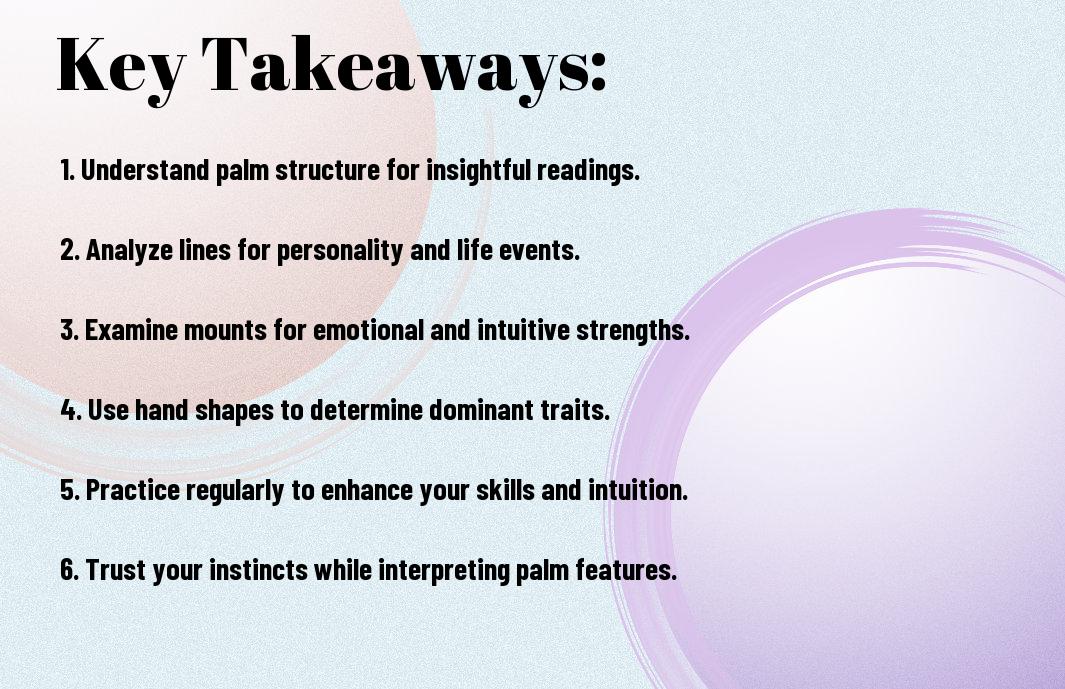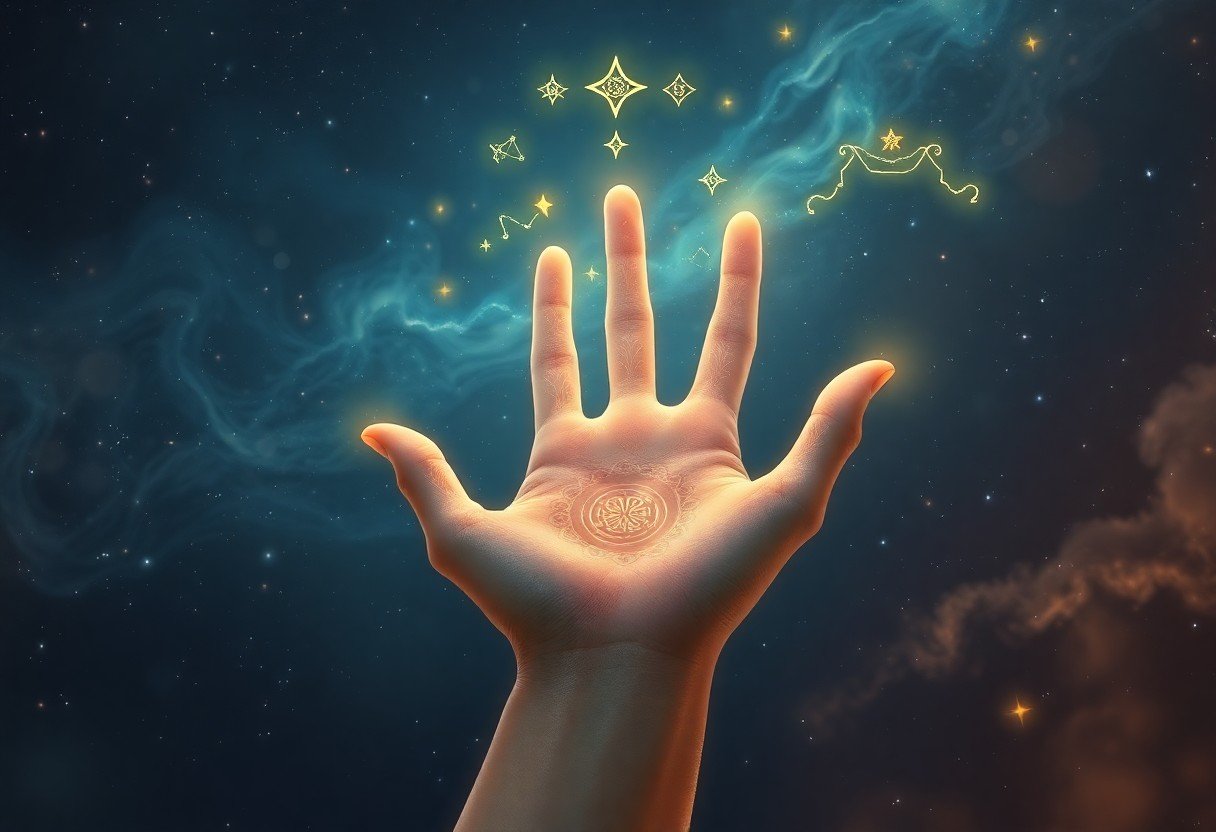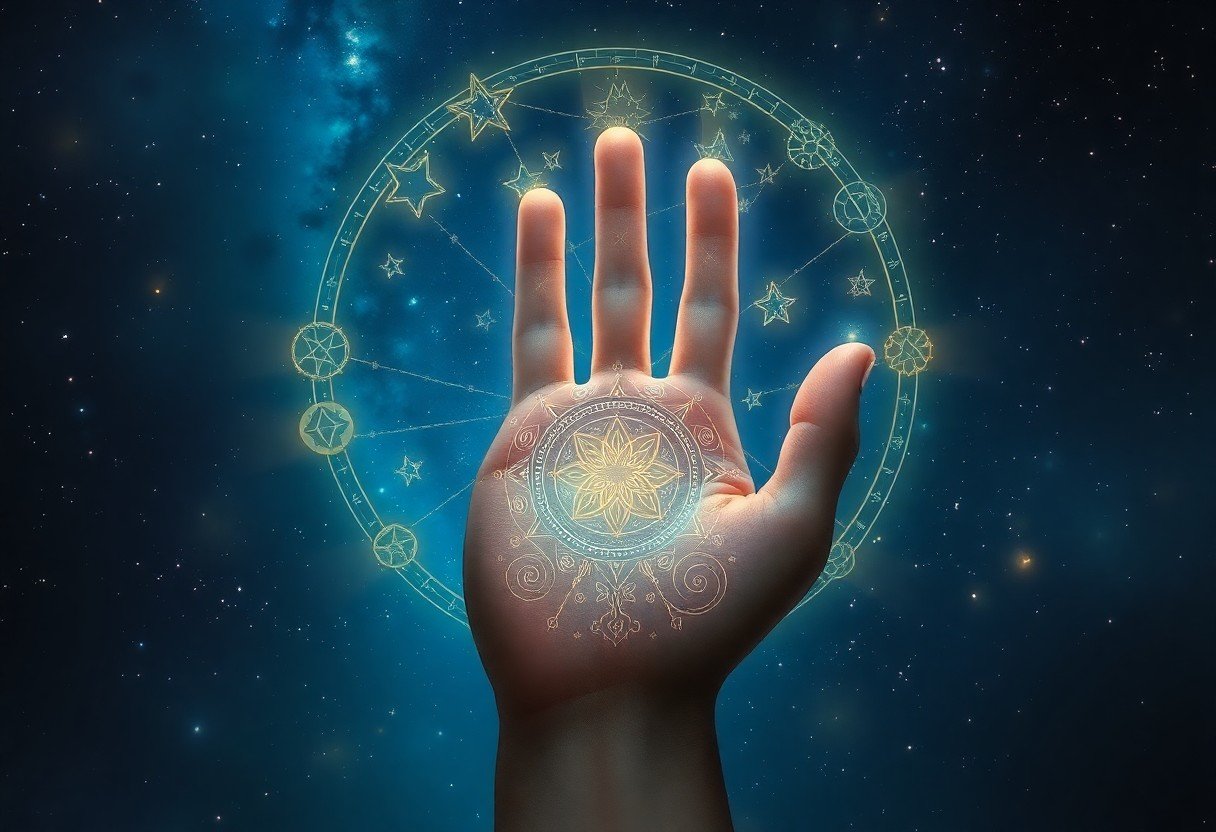This palmistry guide will help with your psychic potential
Just as every hand tells a unique story, your palms can reveal profound insights into your personality and future. In this comprehensive guide, you will learn step-by-step techniques to interpret the lines, shapes, and mounts of your palms, unlocking your psychic potential and enhancing your intuition. By understanding the language of palmistry, you can gain clarity on personal relationships, career paths, and emotional well-being. Dive into this fascinating world and discover how you can use palmistry to empower your life.
Key Takeaways:
- Palmistry involves analyzing the lines, shapes, and features of the hands to gain insights into personality and potential future events.
- The major lines on the palm include the heart line, head line, and life line, each representing different aspects of an individual’s life.
- The mounts of the palm, located at the base of each finger, provide additional information about a person’s traits and inclinations.
- Hand shapes and finger lengths are important factors that can influence the interpretation of a reading.
- Practicing palmistry enhances intuitive abilities and can foster a deeper connection to one’s own psychic potential.
- To begin, familiarize yourself with the basic concepts, and gradually progress to more advanced techniques and interpretations.
- Regular practice and observation of different hands will improve accuracy and deepen understanding of the art of palmistry.
The History of Palmistry
Before exploring into the practice of palmistry, you might find it fascinating to learn about its rich history. Palmistry, or chiromancy, dates back to ancient civilizations, with its origins traced to India, China, and Egypt. Each culture ascribed unique meanings to the lines and mounts found on the palm, and palmistry often intertwined with mysticism and spirituality. In India, for example, palmistry is not merely a form of divination but an integral part of traditional Ayurvedic practices, believed to offer insights into one’s destiny and personality. The Egyptians, on the other hand, viewed the hand as a microcosm of the human experience, encapsulating everything from fate to character.
Origins and Cultural Significance
After understanding its initial cultural significance, you will appreciate how palmistry has influenced various societies throughout history. In ancient Greece, philosophers like Aristotle and Hippocrates contributed to the study of palmistry, emphasizing its relevance in identifying psychological traits and health issues. The Greeks further expanded its practice, intertwining it with astrology and the examination of facial features. During the Renaissance, interest in palmistry surged in Europe, as scholars and nobility sought to unlock the secrets of the soul through hands. This period marked a shift toward a more scientific approach, with practitioners documenting their findings, thus paving the way for modern interpretations.
Evolution Through the Ages
Significance is also found in the evolution of palmistry through various eras, as it adapted to the cultural and philosophical shifts of the time. During the Middle Ages, palmistry often faced skepticism, with practitioners sometimes labeled as fortune-tellers or charlatans. However, the 18th and 19th centuries saw a resurgence in its popularity, coinciding with the rise of Romanticism and the occult. This rekindled interest led to the establishment of palmistry as a legitimate practice, supported by numerous texts and studies that laid the groundwork for its contemporary application.
Also, you will encounter how modern palmists incorporate both traditional insights and contemporary psychological principles into their readings. The development of palmistry has made it more accessible, allowing you to explore your potential without the biases that once surrounded its practice. This evolution signifies a broader acceptance of self-awareness and personal growth, inviting you to investigate deeper into your own psyche through the art of palmistry.

Understanding the Major Lines
You will find that palmistry relies heavily on the interpretation of three major lines: the Heart Line, the Head Line, and the Life Line. Each of these lines holds different insights into your personality, emotions, and life path, helping you to uncover your psychic potential. As you investigate into these lines, you will learn how they reflect various aspects of your existence and provide guidance in your personal journey.
The Heart Line
Around the top of your palm, you will locate the Heart Line, which is pivotal in revealing your emotional well-being and romantic inclinations. This line indicates your capacity for love, relationships, and emotional connections. If your Heart Line is long and deep, it signifies a strong ability to express emotions. Conversely, a short or broken line may suggest challenges in relationships or emotional struggles.
The Head Line
With your focus on the Head Line, you will discern its representation of your intellect, decision-making abilities, and thought processes. This line typically extends horizontally across the palm and its characteristics can provide insight into how you approach challenges or rationalize experiences. A well-defined Head Line signifies a logical thinker, whereas a wavering line may indicate a more indecisive or scattered thought process.
This line is particularly significant when analyzing your problem-solving approach and creativity. If the Head Line is straight and even, it often points to a fact-based approach, while a curved line may suggest a more imaginative or spontaneous mindset. Recognizing these traits can enhance your self-awareness and help harness your intellectual strengths.
The Life Line
Among the three major lines, the Life Line is perhaps the most discussed, as it reflects your life journey and vitality. Contrary to common belief, it does not indicate the length of your life but rather the quality of your experiences, including your physical health, energy levels, and significant life changes. A well-defined Life Line often signifies a strong sense of vitality, while a faint or broken line could suggest periods of low energy or health concerns.
The connection between your overall health and this line can offer insights into how lifestyle choices affect your well-being. A continuous Life Line signifies stability and good health, while interruptions might hint at transformative events or periods of uncertainty. Being attuned to this line can empower you to make choices that enhance your physical and emotional wellness.
The Minor Lines and Their Meanings
All those intrigued by palmistry will find that the minor lines on your palm provide additional insights into your personality and life experiences. These lines convey subtle nuances that can indicate your emotional depth, creativity, and unique challenges. While the major lines like the Heart, Head, and Life lines are significant, the minor lines add layers to your understanding of self, helping you to discover your psychic potential and navigate your life more effectively.
Fate Line
Between the multiple lines on your palm, the Fate Line stands out as it reveals your life path, career trajectory, and how external circumstances influence your journey. If you have a well-defined Fate Line, it suggests that you have a strong sense of purpose and a clear direction in your life. Conversely, a faint or broken Fate Line might indicate a more turbulent path or a struggle to find your vocation. This line can also reflect changes in your professional life, showing key events that shaped your career.
Sun Line and Mercury Line
Behind the scenes of your palmistry reading, the Sun Line and Mercury Line are often overlooked yet hold significant importance. The Sun Line, often associated with fame and creativity, indicates your ability to express yourself artistically and gain recognition for your talents. A prominent Sun Line may suggest a natural artistic gift or an inclination towards acquiring a status in your field. On the other hand, the Mercury Line reflects your communication skills and intellect. A strong Mercury Line can indicate a knack for persuasion and cleverness, which may benefit your career and personal relationships.
Considering the Sun and Mercury Lines more closely, you can uncover insights related to your life’s mission and the way you interact with the world around you. If your Sun Line is long and bright, it may denote a life filled with positive attention and achievements. In contrast, if the line appears short or fragmented, you may face challenges in self-expression or artistic pursuits. The Mercury Line, when well-formed, can signify effective communication, important for building connections and navigating social dynamics. By understanding these lines, you enhance your ability to tap into your strengths and address areas for improvement, ultimately unlocking more of your psychic potential.

The Shape and Mounts of the Palm
Despite the complexity of palmistry, the shape of your hand and the mounts found on your palm can reveal fascinating insights about your personality and potential. Each hand shape corresponds to specific elements—earth, air, water, and fire—offering a glance into your innate traits. Understanding your hand’s shape allows you to uncover more about who you are and guide you in your personal growth. The mounts on your palm, which are the raised areas at the base of your fingers and palms, also play a significant role in this process.
Types of Hands
After you determine your hand shape, you can classify them into four primary types based on their characteristics:
| Hand Shape | Element |
| Earth Hands | Practical and reliable |
| Air Hands | Intellectual and communicative |
| Water Hands | Emotional and intuitive |
| Fire Hands | Passionate and energetic |
Continuing to explore your palm’s unique features, you’ll find that the mounts, specifically the fleshy pads beneath each finger and palm, provide additional insights into your character. By evaluating the mounts, you can uncover the strengths and challenges associated with different aspects of your life. Each mount corresponds to various traits, such as ambition, creativity, and emotional depth.
The Mounts and Their Significance
By paying attention to the size and shape of each mount, you can gain greater understanding of your natural tendencies and inclinations. For instance, a well-developed Mount of Venus suggests you’re likely to be affectionate and sensual, whereas a flat Mount of Jupiter might indicate a lack of ambition or leadership inclination. Caring for yourself and enhancing your strengths can lead to an enriched personal journey.
Considering the significance of these mounts allows you to probe deeper into your personal psyche. It’s vital to observe not just their size but the overall condition of each mount. A prominent mount may indicate a strong drive and passion for that trait, while a recessed mount could point to a lack of development in that area. Keep in mind that each person’s palm is unique, and the interplay of various mounts contributes to the overall narrative of your life journey, revealing both your potential and areas for growth.
Techniques for Reading Palms
Observational Skills
To effectively read palms, you must develop sharp observational skills that allow you to notice the subtleties in palmistry. This starts with examining the basic characteristics of the hand, including its shape, size, and the length of the fingers. The dominant hand typically reflects your present and future, while the non-dominant hand provides insight into your past. Learning to identify different hand types, such as earth, air, fire, or water hands, can also help you understand various personality traits that influence the readings.
Across the palm’s surface, you’ll find an array of features that contribute to its unique narrative, such as the primary lines, mounts, and the overall skin texture. The lines you examine, notably the heart line, head line, and life line, contain vital information about emotional patterns, intellectual tendencies, and longevity. Paying close attention to variations—such as line depth, breaks, or forks—can provide further layers of meaning that enhance your understanding of an individual’s life journey.
Interpretation Methods
To make meaningful interpretations from the various aspects of the palm, you’ll need to familiarize yourself with different interpretation methods. A common approach is to create a framework that links specific palm characteristics to particular life themes or personality traits. For example, a smooth and unbroken heart line often indicates a stable emotional life, while a broken line might signify emotional turmoil. You can enhance your readings by blending these methods to formulate a comprehensive perspective on the person you are interpreting.
Even as you probe into interpretation methods, it’s vital to remember that no two palms are alike, and thus, each reading requires a personalized touch. Combining your intuition with the learned principles will allow you to identify the positive and negative influences present in someone’s palmistry. As you grow in this practice, you may find that your own interpretations deepen, and your confidence increases as you uncover layers of meaning within every hand you read.

Common Misconceptions About Palmistry
For many, palmistry is shrouded in mystery and misconceptions. Some people believe that palm reading is merely a form of entertainment, associating it with fortune-telling and superstition. However, this ancient practice goes far beyond the simplistic notion of predicting the future. Instead, palmistry provides insights into your personality, emotional landscape, and life challenges. If you’re curious about what palm reading is all about and whether anyone can learn it, check out this resource to deepen your understanding.
Myths vs. Facts
By addressing the myths surrounding palmistry, you can cultivate a more accurate and respectful view of the practice. One common myth is that palmistry is merely a party trick, with its roots in entertainment rather than serious study. In reality, palmistry has a rich history and encompasses philosophy, psychology, and even elements of spirituality. Another misconception is that palmistry is limited to fate; instead, it can serve as a guide for personal development, highlighting your strengths and potential challenges.
How to Approach Readings Ethically
Approach palmistry with a sense of responsibility and respect, especially when it involves other people’s hands and life stories. Ethical readings emphasize informed consent, ensuring that you only read the palms of those who are willing and curious. Additionally, it is vital to avoid making definitive predictions that could lead to anxiety or reliance on fate. Instead, frame your insights positively, offering constructive guidance that empowers the individual to make their own choices. Establishing clear communication about the purpose of the reading can further enhance the experience.
Further, a strong ethical foundation ensures that readings remain beneficial rather than detrimental. Approach each session with the goal of providing *insight* rather than *foretelling doom*. Encourage those you read for to *reflect on their own choices* and *take charge of their lives,* reminding them that while palmistry can offer guidance, the ultimate *power lies within themselves*. By balancing your insights with ethical considerations, you create a safe space for personal explorations and growth.
Conclusion
On the whole, this step-by-step guide to palmistry provides you with a comprehensive understanding of how to unlock your psychic potential. By learning the various lines, shapes, and mounts on your hands, you will gain valuable insights into your personality, life experiences, and future possibilities. Embracing palmistry invites you to probe deep into self-discovery, enabling you to navigate your life journey with heightened awareness and clarity.
As you incorporate the knowledge gained from this guide into your practice, you can further refine your skills and develop a unique approach to palmistry that resonates with you. By continuously observing and interpreting the hands of yourself and others, you will cultivate your intuitive abilities, allowing you to both uncover personal truths and assist those around you. Embrace this fascinating art as a tool for personal growth and transformation, and enjoy the journey of exploring your psychic potential through the ancient practice of palmistry.
FAQ
Q: What is palmistry and how does it relate to discovering my psychic potential?
A: Palmistry is the art of interpreting the lines, shapes, and features of the hands, particularly the palms, to gain insight into an individual’s character, personality traits, and potential future events. By studying your own hands, you can uncover deeper layers of understanding about yourself, which can enhance your psychic abilities.
Q: Do I need to have any special skills to start learning palmistry?
A: No prior experience or special skills are required to start learning palmistry. The guide is designed for beginners and provides step-by-step instructions that will help you develop your understanding of hand analysis and improve your intuitive abilities.
Q: How can studying palmistry help me in my daily life?
A: Learning palmistry can provide insights into your strengths, weaknesses, and life path. It allows you to gain a greater self-awareness and understanding of others, which can lead to improved relationships, better decision-making, and enhanced personal growth.
Q: Is palmistry based on scientific principles?
A: While palmistry is often considered a metaphysical practice, it draws on observations and interpretations that some individuals find resonant. It is important to approach it with an open mind and see it as a tool for self-exploration rather than a scientific determinant of fate.
Q: Can palmistry predict my future accurately?
A: Palmistry can offer insights and suggest potential trends based on the lines and features of your palm, but it does not provide definitive predictions. It’s more about understanding possibilities and patterns that may influence your path rather than exact outcomes.
Q: How long will it take to become proficient in palmistry?
A: Proficiency in palmistry varies from person to person, depending on how much time and effort you dedicate to studying and practicing. With consistent practice and engagement with the materials in the guide, many individuals begin to see significant improvement within a matter of weeks or months.
Q: Are there other resources I should consider alongside this guide?
A: While the step-by-step guide provides a strong foundation, you may also choose to explore additional books, workshops, or online resources that probe into advanced aspects of palmistry and psychic development. Engaging with a community of practitioners can also enhance your learning experience.









0 Comments